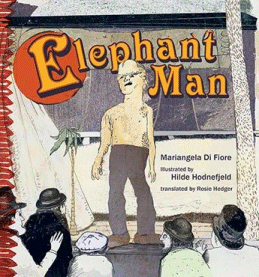Elephant Man
Elephant Man
Mariangela Di Fiore
Hilde Hodnefjeld
Translated by Rosie Hedger
Allen & Unwin, 2016
48pp., hbk., RRP $A29.99
9781760292201
The publishers’ blurb says it best…
“’Gather round – prepare to be amazed! A sight so very gruesome that you simply won’t believe it. Ladies and gentlemen – THE ELEPHANT MAN!’
Joseph doesn’t look like other people. His skin is thick and lumpy, his limbs are oddly shaped, and his head has a big bony bump. People call him Elephant Man and scream in terror when they see him. But inside, Joseph longs for a friend to understand him.
As Joseph is bullied and rejected at every turn, his situation grows more and more desperate. But a meeting with a kind doctor holds the hope to change his life
Based on the famous true story of Joseph Merrick, Elephant Man is a powerful tale about being different, finding happiness in even the hardest circumstances, and discovering beauty inside everyone. The unforgettable true story of one young man’s immense courage and his unbreakable spirit.”
This is a heart-breaking but uplifting story of a young man so badly deformed that he was sent to one of the infamous workhouses of 19th century England at a time when any disability – physical or mental, visible or invisible – was treated with such suspicion that the only solution by ‘genteel society’ was to lock the sufferers away. “Out of sight, out of mind” would summarise the concept well. Seeking to escape, Joseph found that exhibiting himself in a human oddities show had more appeal than the life he was living – a sad indictment of the times, indeed. But out of the inhumanity comes Frederick Treves who changes Joseph’s life…
Merrick’s life has been the subject of books, films, plays and documentaries so that over 100 years on, it is still a fascination. This picture book, based on fact but ficitionalised by the inclusion of thoughts and conversations, and cleverly sprinkled with original photos and documents, might seem to have little place in the collection of a primary school of the 21st century. But it’s value is far-reaching for all Joseph really wanted was to be accepted for who he was inside, not his external appearance; as a person first and a person with an illness last. Extreme example it may be, but what a discussion starter for body image, racism, religious perspectives and all those other characteristics that judgements are made on. Older students might even examine Hitler’s view of ‘Aryan supremacy’ or Jane Elliott’s Blue Eyes/Brown Eyes exercise.
The book also stands as a testament to how far we have come in our perception and treatment of those who are not “perfect” in a very short time in human history. As we mark the centenary of World War I, students are reading of those who returned disabled and “shell-shocked”, often shunned by society and certainly with little social support as attitudes did not change. Indeed, the biggest turnaround was in 1981 in the UN-declared International Year of Disabled Persons and there was a global spotlight on each nation having a plan of action for “equalization of opportunities, rehabilitation and prevention of disabilities.” From looking at something as basic as entry into public buildings we now have federal government legislation Disabled Standards for Education which demands that we adapt our environments and our teaching for inclusivity. While there is still much to do, gradually we are getting there and it is the understanding, tolerance and idealism of our young that will continue the march. We should do these things because they are the right thing to do not because we are compelled by legislation.
Elephant Man is not a gratuitous story about some freak-show oddity – it is a story about a man whose message reaches out across time to teach us so much about belonging, compassion and identity. There is more information about Joseph Merrick at Biography.com
